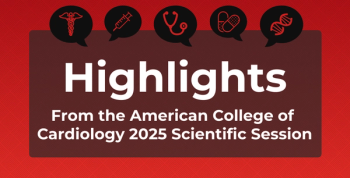
Evidence-Based Diabetes Management
- December 2018
- Volume 24
- Issue 14
A Paradigm Shift Highlights the Need to Reduce CV Risk in Diabetes
From the Editor in Chief of Evidence-Based Diabetes Management.™ Dr Gabbay is senior vice presdient and chief medical officer of Joslin Diabetes Center in Boston, Massachusetts.
The 2019 Standards of Medical Care in Diabetes, recently published by the American Diabetes Association (ADA), marks a milestone that few might have imagined a decade ago. Given the discovery in recent years that diabetes medications differ significantly in how they affect cardiovascular disease, the American College of Cardiology (ACC) endorsed a chapter on cardiovascular disease and diabetes care, just weeks after the ADA had similarly endorsed the ACC’s new consensus pathway on the care of patients with type 2 diabetes (T2D) and atherosclerotic cardiovascular disease (ASCVD).1,2
Such collaboration shows that preventing heart attacks, strokes, chronic kidney disease, heart failure, and early death from cardiovascular causes is no longer something we hope for in diabetes management. As outlined in this issue, we expect to see more collaboration between endocrinologists and cardiologists in the management of cardiovascular risk. We at Joslin Diabetes Center have begun a series of discussions with the local cardiology community on how to best co-manage these patients and ensure they get this needed treatment. This is something that physicians and people living with diabetes should expect, thanks to the arrival of new therapeutic classes—the glucagon-like peptide-1 (GLP-1) receptor agonists and the sodium glucose cotransporter 2 (SGLT2) inhibitors. The Joslin clinical guidelines (published in June in Evidence-Based Diabetes Management™) reflect that these are the preferred agents for patients with T2D and established cardiovascular disease; GLP-1 receptor agonists are advised for patients with ASCVD, while SGLT2 inhibitors have been shown to reduce hospitalization and mortality for patients with a history of heart failure.3
We understand the value of these therapies because in 2008, the FDA acted in the interest of patient safety and required manufacturers to undertake cardiovascular outcomes trials (CVOTs). CVOTs are large, highly regulated studies aimed at ensuring the safety of diabetes drugs but have fortuitously demonstrated reductions in cardiovascular events for these 2 drug classes. It has taken time for those unexpected benefits to make their way into clinical guidelines, but now that they have, diabetes management has a new normal: Not only is it important that glucose-lowering therapies help a patient achieve a glycated hemoglobin target, but how the patient gets there also matters. We want to know that the medication provides benefits that align with the patient’s overall risk profile.
For some stakeholders, the FDA’s recent review of its 2008 CVOT guidance concerned whether the trials should continue, given their cost. Certainly, there are legitimate concerns here. CVOTs are hardly the only reason new drugs are expensive, but the cost of giant trials like FOURIER and ODYSSEY Outcomes factored into the original price tag of the cholesterol-fighting proprotein convertase subtilisin/kexin type 9 (PCKS9) inhibitors, which were initially priced at $14,000 a year before significant cuts in 2018. Many patients with diabetes also have elevated low-density lipoprotein cholesterol, which these drugs can lower by up to 60%.4 But the cost of PCSK9s has kept them from reaching all who could benefit.
Could the next wave of CVOTs be done more efficiently? The answer is likely yes, but that may not be the most important question. The better question is, Where do we go from here? Mikhail Kosiborod, MD, FACC, FAHA, of Saint Luke’s Mid America Heart Institute, is correct when he suggests it is time for a “new goalpost” in our clinical trials. With so many therapies demonstrating a cardiovascular benefit, the time has come to design studies with cardiovascular benefit as a new starting point so that the next wave of drug development can move the bar even further for patients, with perhaps less of a leap in cost. Offering patients more choices earlier on, before diabetes does irreversible damage, will create value for every stakeholder in the system.
Author Information
Dr Gabbay is the senior vice president and chief medical officer at Joslin Diabetes Center. He serves as editor-in-chief of Evidence-Based Diabetes Management.™
References
- American Diabetes Association. Standards of medical care in diabetes—2019. Diabetes Care. 2019;42(suppl 1). care.diabetesjournals.org/content/42/Supplement_1. Accessed December 20, 2018.
- Das SR, Everett BM, Birtcher KK, et al. 2018 ACC expert consensus decision pathway on novel therapies for cardiovascular risk reduction in patients with type 2 diabetes and atherosclerotic cardiovascular disease. J Am Coll Cardiol. 2018;72(24):3200-3223. doi: 10.1016/j.jacc.2018.09.020.
- Hafida S, Ganda OP, Gabbay RA; Members of the Joslin Clinical Oversight Committee. Chapter 1. Clinical guideline for adults with diabetes. Am J Manag Care. 2018;24(spec 7):SP209-SP225.
- Dangi-Garimella S. Amgen announces 60% reduction in list price for PCSK9 inhibitor evolocumab. The American Journal of Managed Care® website. ajmc.com/newsroom/amgen-announces-60-reduction-in-list-price-of-pcsk9-inhibitor-evolocumab. Published October 24, 2018. Accessed December 26, 2018.
Articles in this issue
almost 7 years ago
Medical World News: Clinical Updates, December 2018almost 7 years ago
Medical World News: Managed Care Updates, December 2018almost 7 years ago
Medical World News: Policy Updatesalmost 7 years ago
Guidelines Updates in Diabetes and Cardiovascular DiseaseNewsletter
Stay ahead of policy, cost, and value—subscribe to AJMC for expert insights at the intersection of clinical care and health economics.










































